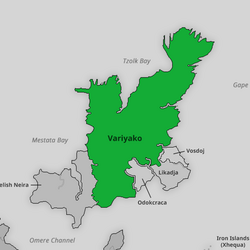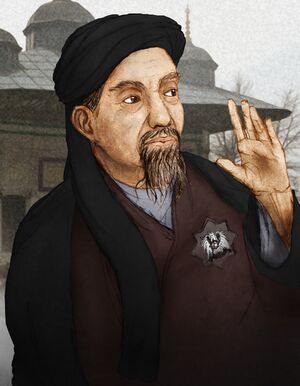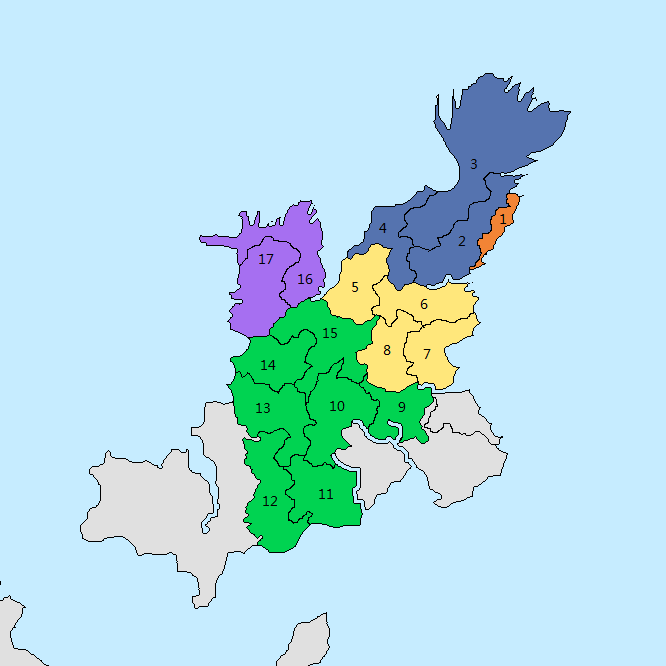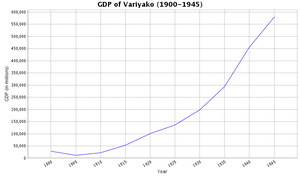Variyako
| Vilakismusi Republic of Variyako ቪለኪሥሙሥ᎐ፂዡዱተከ፡ቨሪጀኮዎ (Vilakismus'ižudutaka Variyakowo) | ||||||
|
| ||||||
| ||||||
| Motto | ||||||
| Justice through Faith | ||||||
| Anthem | ||||||
| My proud Variyako src | ||||||

Variyako after 1908 in Neira | ||||||
| Nation | ||||||
| Capital: | Vulkorovka[1] | |||||
| Largest City: | Mestata | |||||
| Official languages: | Wunal | |||||
| Demonym: | Variyakoi Vilakismusi | |||||
| Politics | ||||||
| Government: | Single-party totalitarian theocracy | |||||
| - Revolutionary Guardian: | Sulejman Lukanov | |||||
| Legislature: | Supreme Kolaji | |||||
| State religion: | ||||||
| Formation: | September 1904 | |||||
| Geography & Demographics | ||||||
| Population: | 49,345,000 | |||||
| Ethnic groups: | Variyakoi, Tzolk, Zeleovkian | |||||
| National minorities: | Odokcracian, Likadjai, Xhequan, Justvakaun, Atraethean | |||||
| Time zone: | SMT +6/+7 | |||||
| Economy | ||||||
| Currency: | Anbra (ነ)(?) | |||||
| GNP: | Ꭶ37,983 million ([1]) | |||||
| Core industries: | Soy, cotton, lumber, coal, iron, copper, gold, textiles, livestock, slaves, fish | |||||
| Primary imports: | Wheat, silver, gemstones, industrial goods, spices, wines, fruits, arms | |||||
| [Source] | ||||||
The Vilakismusi Republic of Variyako (Wunal: ቪለኪሥሙሥ᎐ፂዡዱተከ፡ቨሪጀኮዎ tr. Vilakismus'ižudutaka Variyakowo) is a country in Neira. It is bordered by Likadja to the east, Odokcraca to the south east, and Atraelish Neira to the south west. It also shares a maritime border with Xhequa. It is the largest nation on the continent of Neira, and has the world's eighth largest population at 34,900,000 people, placing it ahead of Iqualna but behind Nuntu. Its capital is Vulkorovka, being located on the south coast of the nation and the largest city is Mestata on the northwest coast.
Modern Variyako can trace its lineage to the Kingdom of Mestata, a wealthy port-city that dominated the western coast. In 114BCE a group of prophets complied the Iszotec and created the Ravadi, commonly seen as the beginning of Soziti faith. In 100BCE King Žaraǰodaši I declared Soziti as the state faith, renaming the country as the Sublime Zanikoji of Variyako and being confirmed as the Zanikoj[2]of Soziti. The Sublime Zanikoji led a series of expansionist wars known as the Variyakoi Unification Wars from its creation up until the 1300's which assimilated the disparate Wunal speaking people's and tribes on Neira into one political entity. In 1310 the start of the Variyakoi-Xhequan War ended Variyakoi expansionism as Xhequa invaded and occupied swathes of Neira before being beaten back by Variyako by 1400, who absorbed Xhequan protectorates on Neira into its sphere of influence including Umlokovy, Odokcraca, Zeleovki and Justavka. Variyako was also able to annexe Sepercy into its territory as well as engage in a series of conflict with Tzolkun. Between 1425 to 1700 Variyakoi culture flourished as it became an innovator in science, technology, literature and art as well as encountering economic prosperity and territorial expansion. Grain shortages, famines, societal breakdown and lack of internal reforms led Variyako to enter a period of decline in the 1700's which failed to be reversed by the ultra-conservative, theocratic establishment of feudal landlords, the crown and priests. Hyperinflation, famine, ethnic tensions, lack of modernisation, economic stagnation and growing nationalism led to the Variyakoi Civil War between 1865 - 1876 which led to the independence of Odokcraca and rebellions across the Zanikoji. After the war Variyako transformed Umlokovy, Zeleovki and Justavka into de jure protectorates as a concession to nationalists but otherwise maintained the same socio-economic and political superstructures that were in place prior to the war. The Atraelish invasion of Justavka in 1884 forced the imperial government to make tepid reforms and build an alliance with Xhequa and Saeyri, although it vehemently opposed liberalism, secularism, constitutionalism, industrialism, capitalism or any other moves that would upset the interests of the socio-economic elites.
At the offset of the First World War Variyako launched an invasion of Tzolkun. The invasion resulted the collapse of the Imperial Army leading to societal, sectarian and ethnic tensions in Variyako to explode starting the Variyakoi Revolution, with provinces under the control of regional warlords going to war against the imperial government. The revolution led to the overthrow of the Zanikoji by the Atraelish backed National Revolutionary League who created the short lived Variyakoi People's Republic which was later itself defeated by the Labour Vilakismus Front, a far-left group that endorsed Vilakismusi ideology under the control of Sulejman Lukanov. The LVF created the Vilakismusi Republic of Variyako in 1904, a one-party socialist theocracy, which by 1908 had taken control of Variyako alongside Umlokovy, Zeleovki, Tzolkun and Zavoykun.
History[edit | edit source]
Prehistory[edit | edit source]
The first human species to migrate to Neira were the Homo neirai in 120,000 BCE, who moved from Cymlun after the continent suffered from a series of crippling droughts. The H. neirai quickly adapted to the colder climate and soon migrated across much of modern day southern Variyako, dominating the continent in a short space of time, forming hunter-gatherer societies. Around 80,000 BCE modern humans migrated to Neira and started to displace H. neirai through interbreeding and fighting over hunting grounds, with H. neirai dying out soon afterwards. Around 10,000 BCE Neiran people's began to develop new agricultural techniques, herding livestock and growing primarily cotton, which would become a key Neiran export throughout history. First records of trade can be traced back to 7000 BCE when Cymluni merchants traded ploughs with Neiran tribes.
Kingdom of Mestata[edit | edit source]
- Main article - Kingdom of Mestata
The modern Variyakoi state was the successor of the Kingdom of Mestata. Mestata was a port town that was on the trade route from the Oemre Channel to the Sevanica Straits. As such Mestata was a vital trading outpost on the Neiran continent, controlling various smaller ports and maintaining a series of tariffs. Several lords often tried to sack the city or take the mantle of King, with numerous short lived dynasties replacing each other in quick succession. However a steady flow of trade enabled Mestata to become extremely wealthy as it built up a trading empire.
This wealth enabled the Kingdom to attract many intellectuals. The Kingdom had no real religion, with traditional tribal beliefs and Shamanism dominating people's lives. Various religions and faiths resided in the city with relative religious tolerance being observed by the ruling elite who were engaged in constant power struggles. In 114BCE a group of philosophers claimed to have all seen a message from God, and recorded this message in a book named the Iszotec [3]. The Iszotec preached that there was one God who would one day purge all life from the world unless humanity followed his teachings. These philosophers formed the first Ravadi in Mestata, and began to preach their new faith named the Soziti.
According to legend, these Sozitists were courted by the King of Mestata Žaraǰodaši I, who was enraptured by the Sozitists preachings and converted to Soziti himself. With this conversion the Ravadi appointed Žaraǰodaši as the Zankoj, the divine leader of Soziti and God's Prophet on earth. The Zanikoj subsequently declared that his opulent palace be the Temple of Soziti, and appointed the Ravadi as his closest advisors. He then decreed that the people follow the Soziti faith, and that henceforth the nation would be known as "Variyako" (Land of God).
Sublime Zanikoji[edit | edit source]
- Main article - Sublime Zanikoji of Variyako
Unification Wars[edit | edit source]
Variyakoi-Xhequan Wars[edit | edit source]
Variyakoi Golden Age[edit | edit source]
Age of Stagnation[edit | edit source]
Variyakoi Revolution[edit | edit source]
Vilakismusi Republic[edit | edit source]
Lukanov[edit | edit source]
Geography[edit | edit source]
Variyako is a mountainous country with plains in its north and southeast, with the Našok mountain range in the northeast and Hovzemku-Variyakoi range in the southwest effectively splitting the country into two halves. Its highest point is Mt. Hajozać, which stands at 8,585 metres tall, making it the world's third tallest mountain, above Mt. Abka in Gakkni (at 8,519m) and below Maksumaj and Doržaj in Likadja (8,768m and 8,810m respectively). Variyako's flora is dominated by marcescent and deciduous trees as well as hardy climate adapted grasses.
Politics[edit | edit source]
Governance[edit | edit source]

The Vilakismusi Republic of Variyako is officially a "government of the blessed masses", as stipulated by the supreme law of the country, the Holy Directive of Worker and Peasant Emancipation, who are guided by God alone, utilising a system of governance popularly known as Vilakismui democracy, which is distinct from its liberal counterpart. Sovereign power is officially held by the people of Variyakoi, who elect using a single non-transferable vote 8 candidates in 3,200 electoral wards (which correspond with Iznilas/Retovos), which each district making up 1 local Kolaji (People's Council), local administrative bodies that in turn elect 140 Kolaji's for the Vovens that themselves elect 31 Verneris Kolaji whom elect the 5 Oblast Kolaji. The Oblast Kolaji are responsible for electing the Supreme Kolaji, comparable to a national legislature although the Holy Directive asserts that local Kolaji are intended to be "above" the Supreme Kolaji, who cannot override the democratic will of local Kolaji. The Holy Directive also outlines that the Ravadi[4] holds no official power other than to communicate the word of God, whose law is above that of any of mankinds. There are no political parties or organisations that officially exist being banned under the Holy Directive. However several "people's fronts" exist with the main one being the Labour Vilakismus Front, which is recognised as a manifestation of God's will, and who are tasked with the appointment of the Ravadi as well as control of the other fronts (eg. the Labour Union, Labour Womens Front and Labour Youth Fronts).
Whilst in theory a decentralised republic, the declaration that God's laws override all native Variyakoi laws and that the Ravadi - picked from the Labour Vilakismus Front - are the only ones with the right to communicate and interpret God's laws give the Ravadi and the LVF de facto unlimited power over Variyako. The Ravadi acting as a de facto executive government and the LVF as state functions, with the army, civil bureaucracy, religious priests and all Kolaji delegates being either members of or under control of the LVF, whose approval is needed in order to participate in civil society. As such Variyako functionally is governed as a single party state.
Within the LVF whilst the highest executive body is the Ravadi (which lacks an official leader) the most powerful organ is the Guardians of the Vilakismusi Revolution. The GVR are officially seen as God's chosen people to preserve the Vilakismusi Republic, and as such serve as the regime's secret police. Their own leader, the Holy Guardian of the Vilakismusi Revolution, is recognised both as the leader of the LVF and God's prophet on earth, meaning that the Holy Guardian in practice acts as the supreme leader and autocrat of Variyako.
Ideology[edit | edit source]
Administrative Divisions[edit | edit source]
Variyako is divided into five autonomous oblasts (who reserve the rights of overseeing and implementing various devolved powers in a de jure system of asymmetric federalism. Oblasts are further divided into 17 Verneris (provinces) which are themselves divided into 140 Vovens (counties) which are then divided into either Iznilas in rural areas or Retovos in urban one, with their being 3,200 Iznilas/Retovos overall.
Human Rights and Persecution[edit | edit source]
Military[edit | edit source]
Legal system[edit | edit source]
Foreign Policy[edit | edit source]
Law enforcement[edit | edit source]
Economy[edit | edit source]
Variyako since 1908 has possessed a planned command economy with the state owning the majority of industries and directing the economy through indicative planning. In 1905 the Variyakoi government oversaw land reform in terms of agriculture as well as nationalising industry and mines, with an Eight Year Plan commissioned in 1908 that had the government direct target for industries through the Agricultural and Industrial Coordination Committee (AICC), replacing a previous system from 1905-8 when workers' in factories via trade union controlled production through workers' self management. In 1921 the Kocopov Commission called for greater industrialisation, prompting the AICC to extend its control over almost all the economy (save agriculture) and sponsoring heavy industry. In 1943 it was decreed that Variyako had finished "preliminary industrialisation" and started to invest in consumer goods. In 1950, the government began collectivising farms in order to invest in more industry, and in 1966 started to privatise smaller state owned industries whilst retaining economic planning and control of the "commanding heights" of the economy.
Currency[edit | edit source]
Agriculture[edit | edit source]
Industry[edit | edit source]
Mining[edit | edit source]
Demographics[edit | edit source]
Ethnic groups[edit | edit source]
Language[edit | edit source]
Society[edit | edit source]
Religion[edit | edit source]
Slavery[edit | edit source]
Status of women[edit | edit source]
Same-sex activity[edit | edit source]
Culture[edit | edit source]
Architecture[edit | edit source]
Literature[edit | edit source]
Variyako has a strong literary tradition both in oral and written form. Oral literature usually takes the form of folk poems that contain flowing narratives and were set to traditional Variyakoi music, and flourished throughout Variyakoi's early history. The spread of Soziti and the Wunal script resulted in many of these poems being put into written format which had previously been used to record traditional Variyakoi myths and legends, although often in non-poetic formats. In 81 CE Zanikoj Dragaš I ordered scribes to record all the poems in Variyako, resulting in the flourishing of Variyakoi literature. During this period several Variyakoi classics such as The Tale of the Red Mountains, Oberonivicya and the Journey of Vyslavachev Sumarokov were published. This period came to end when Radoslav XI executed hundred of intellectuals and writers in 881CE. From 881CE - 1449CE Variykoi literature was dominated by religious themes and largely stagnated. In 1449 there was a revivalist movement within Variyakoi literature that was proto-romantic, with greater themes of nationalism and exploration into traditional Variyakoi myths. Poetry became more descriptive and less reliant on narrative clichés. The dominant writer of this period was Maximovich Živković. However, this literary bloom soon went into decline again as literature became more uniform and less experimental, as religious themes continued to dominate.
Writers in Zanikoj-ruled Variyako were placed under censorship laws, resulting in much of modern Variyakoi literature to be published overseas. Modern written Variyakoi literature tends to emphasise traditional poetry that deal with common themes of love, joy, sorrow and religion. Oral literary traditions were not subject to censorship and remain extremely dominant amongst Variyakoi citizens. Due to the vast majority of Variyakoi's living in poverty oral folk tales continued to be the primary form of entertainment.
Marriage[edit | edit source]
Traditional Variyakoi families are heavily patriarchal with the oldest male always being the head of the family and family inheritance (prior to 1940) being restricted to men. It is still traditional for Variyakoi families to live closely together, with most households having up to four generations of one family living together.
Traditionally Variyakoi marriages were complex affairs. A marriage would be arranged between two families by a matchmaker, with families expected to pay either a dowry or bride price (with the family of a higher rank paying less). Subsequently the spouse from the family of a higher rank would be expected to engage in polygyny or polyandry with the siblings of the lower ranking spouse, although men regardless of social rank were always allowed to keep concubines. Prior to marriage reform child marriage was not uncommon. Marriage reform in 1914 and 1986 saw the banning of concubinage, forced marriage and child marriage alongside severe restrictions on arranged marriages, dowries and bride prices. Economic pressures have also led to a decline in polygamous marriages, although such marriages are still existence in some parts of Variyako.
Music[edit | edit source]
Variyako had traditionally used string instruments in folk music, which have been a tradition for millennia. The Orpolzhasya[5] remains the most popular folk instrument in Variyako.
Notes[edit | edit source]
- ↑ Previously referred to as Anya; before that Yukochyna
- ↑ A Zanikoj is seen in Mizeykehoi Kruiči Soziti as God's prophet on earth
- ↑ Iszotec is an ancient Wunal word for "prophecy".
- ↑ The Ravadi is the highest body of priests who collectively interpret Soziti doctrine.
- ↑ Equivalent to a real life balalaika



